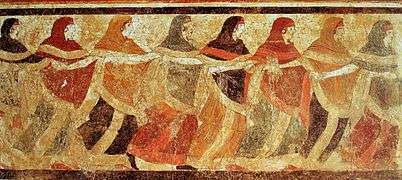Peucetians

The Peucetians (Greek: Πευκέτιοι, translit. Peukétioi; Latin: Peucetii, later also Greek: Ποίδικλοι, translit. Poidikloi; Latin: Poediculi) were a Iapygian tribe which inhabited western and central Apulia in classical antiquity. Two other Iapygian tribes, the Daunians and the Messapians, inhabited northern and southern Apulia respectively. All three tribes spoke the Messapian language, but had developed separate archaeological cultures by the seventh century BC. The Peucetians lived in the eponymous region Peucetia, which was bordered by the Ofanto river and the Murge in the north, the Bradano river in the west and the territories of the Greek colony of Taras and the Messapians in the south.[1] This region is mostly coincident with the Metropolitan City of Bari and a part of the Province of Taranto today.
History
They had three important towns: Canosa, Silvium and Bitonto; the present capital of Apulia, Bari, had not much importance.
With increasing Hellenization their eponymous ancestor, given the name Peucetis, was said by Dionysius of Halicarnassus[2] to have been the son of the Arcadian Lycaon and brother of Oenotrus. Lycaon having divided Arcadia among his twenty-two sons, Peucetios was inspired to seek better fortune abroad. This etiological myth is considered by modern writers to suggest strongly that, as far as the Greeks were concerned, the Peucetii were culturally part, though an unimportant part, of Magna Graecia.
Strabo places them to the north of the Calabri.[3] Strabo adds (VI.8) "...the terms Peucetii and Daunii are not at all used by the native inhabitants except in the early times"In the time of Strabo the territory occupied by the former Peuceti lay on the mule-track that was the only connection between Brindisi and Benevento.[4] Pre-Roman ceramic evidence justifies Strabo's classification of Daunii, Peucetii and Messapii, who were all speakers of the Messapian language. There were twelve tribal proto-statelets among the Peucetii, one of which is represented by modern Altamura.
The Encyclopédie under "Peuceti", distinguishes them from another ancient people, the Peucetioe who were living in Liburnia at the head of the Adriatic, with a reference to Callimachus, as quoted in Pliny (H.N. III.21) placing their country in Pliny's day as part of Illyria[5] but modern ethnography treats them as synonyms.[6]
See also
References
- ↑ Carpenter, Lynch & Robinson 2014, p. 2, 18, 34 and 38–39.
- ↑ Dionysius, Roman Antiquites, I.xi.3.
- ↑ "...on the north [of the land of the Calabri], are the Peucetii and also those people who in the Greek language are called Dauni, but the natives give the name Apulia to the whole country that comes after that of the Calabri, though some of them, particularly the Peucetii, are called Poedicli also." (Geography VI.3).
- ↑ "There are two roads from here: one, a mule-road through the countries of the Peucetii (who are called Poedicli) the Dauni, and the Samnitae as far as Beneventum..." (Geography VI.7.
- ↑ on-line text Archived 2007-09-30 at the Wayback Machine.
- ↑ i.e., Ray Laurence, in Cultural Identity in the Roman Empire, 1998, ch. 7 "Territory, ethnonyms and geography: The construction of identity in Roman Italy" "...in Apulia, where the Peucetii were also known as Poedicli..."
Sources
- Carpenter, T. H.; Lynch, K. M.; Robinson, E. G. D., eds. (2014). The Italic People of Ancient Apulia: New Evidence from Pottery for Workshops, Markets, and Customs. New York City, New York: Cambridge University Press. ISBN 9781139992701.
External links
